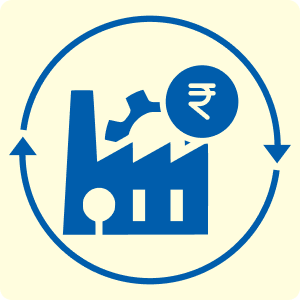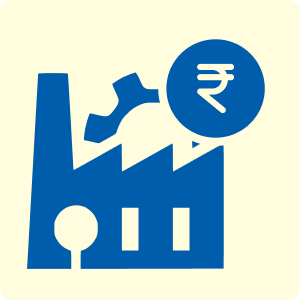A callable fixed deposit is a type of FD that allows the investor to withdraw the deposit before the maturity date. In other words, you have the flexibility to "call" or redeem your deposit at any time, either partially or fully, before the end of the term. This feature provides liquidity and makes callable FDs an attractive option for those who may need access to their funds in case of an emergency or unexpected financial requirement.
Features and benefits of a callable fixed deposit
- Callable FDs offer liquidity to the investor. You can easily access your saved funds to meet financial emergencies despite the applicable penalties.
- Most financial institutions have a low minimum investment requirement for callable FDs, usually starting from Rs. 1,000. This makes callable fixed deposits risk-free and easily accessible investment options for both big and small investors.
- Investing in callable FDs ensures ample flexibility in terms of the investment amount and tenure. Investment tenures vary from 7 days to 10 years. Depending on your budget and financial goals, you can flexibly choose how much you wish to invest and for how long.
What is a non-callable fixed deposit?
A non-callable fixed deposit is a term deposit account that does not offer the flexibility of premature withdrawals. A non-callable FD comes with a fixed lock-in tenure, where the funds deposited cannot be withdrawn before the set maturity date. Exceptions for premature withdrawals may be permitted in special cases like mandate by a court order, bankruptcy filing, or death of the account holder.
The initial deposit amount for a non-callable FD tends to be higher than that of a regular FD. Moreover, such fixed deposits offer higher interest rates than callable FDs, as your funds are locked in for the entire duration of the investment tenure with no option for early withdrawals.
Features and benefits of a non-callable fixed deposit
- The funds invested in a non-callable FD cannot be accessed before the end of the investment tenure. Withdrawals may be permitted in rare instances, such as bankruptcy, court order mandates, and the depositor’s demise.
- Non-callable fixed deposits generally offer higher interest rates as compared to regular callable deposits.
- Non-callable FDs lock in your investment for a predetermined tenure. Generally, this investment period varies from 1 to 2 years.
Key Differences Between Callable and Non-Callable FDs
Feature
|
Callable FD
|
Non-Callable FD
|
Definition
|
A fixed deposit that allows premature withdrawal before the maturity date.
|
A fixed deposit where funds remain locked in until maturity.
|
Interest Rates
|
May be lower, with penalties applied on early withdrawals.
|
Generally more competitive since withdrawals are not allowed.
|
Liquidity
|
Highly liquid, as funds can be accessed in emergencies.
|
Low liquidity; funds are inaccessible until the term ends.
|
Penalty on Withdrawal
|
Premature withdrawals attract penalties, reducing overall returns.
|
Not applicable, as early withdrawals are not permitted.
|
Suitability
|
Best for investors who may need quick access to money.
|
Best for investors aiming for higher returns without needing immediate access.
|
Purpose
|
Useful for short-term goals or uncertain financial needs.
|
Ideal for long-term goals that require disciplined savings.
|
Chances of Breakage
|
Higher, since funds can be withdrawn early.
|
Lower, as money remains locked for the full tenure.
|
Interest rates and returns
When discussing the callable vs. non-callable FD debate, we need to consider interest rates and returns. As mentioned earlier, non-callable FDs offer a higher interest rate than callable fixed deposit accounts. This higher interest rate is compensation for the absence of the premature withdrawal option. Since your investment is locked in for a specific duration, banks and NBFCs can use the funds as stable funding sources, offering you better interest rates on the investment.
Alternatively, callable FDs offer you the advantage of premature withdrawals in exchange for a slightly lower interest rate. In other words, your returns are slightly lower due to the flexibility and liquidity benefits of such FDs. With callable FDs, you essentially trade off higher interest earnings for the possibility of withdrawing funds to meet emergency cash flow requirements.
Eligibility criteria for callable and non-callable FDs
The eligibility criteria for callable and non-callable FDs are largely the same. Both resident and non-resident Indians above 18 years of age can open an FD account under either option. Additionally, legal guardians can open an account on behalf of minors who are over 14 years old.
Apart from individuals, entities such as HUFs, partnership firms, proprietary businesses, clubs, societies, cooperative banks, and educational institutions are also eligible to open callable and non-callable FDs.
To complete the process, applicants are required to submit specific supporting documents at the time of opening the FD account:
- A valid identity proof document like Aadhaar Card, PAN Card, Voter’s ID, Passport, or Driver’s License.
- A valid address proof document like a utility bill, Aadhaar Card, or PAN Card.
Note: This is a general list. The specific eligibility criteria and document list may vary from one financial institution to the next. You should check the eligibility requirements and document list on the bank/NBFC’s website.
Choosing between callable and non-callable fixed deposits
The choice between a callable and non-callable fixed deposit depends on your financial goals, risk tolerance, and need for liquidity. Here are some factors to consider when making your decision:
- Liquidity needs: If you anticipate needing access to your funds before the end of the deposit term, a callable FD may be the better option. However, if you are confident that you will not need the funds, a non-callable FD can provide higher returns.
- Investment horizon: For short-term goals or uncertain financial situations, callable FDs offer the flexibility to withdraw funds when needed. For long-term goals, where the funds can remain untouched, non-callable FDs are more suitable.
- Risk tolerance: Callable FDs carry lower risk due to their liquidity, making them suitable for conservative investors. Non-callable FDs, while offering higher returns, carry the risk of not being able to access funds in emergencies.
Conclusion
Callable and non-callable fixed deposits cater to different types of investors with varying financial needs and risk appetites. Callable FDs offer flexibility and liquidity, making them suitable for short-term goals and emergency funds. Non-callable FDs, on the other hand, provide higher returns and are ideal for long-term savings goals where liquidity is not a concern.









 Deals starting @99
Deals starting @99 Festive deals
Festive deals Min. 50% off
Min. 50% off
 Wallet to Bank
Wallet to Bank
 Loan Against Shares
Loan Against Shares Loan Against Mutual Funds
Loan Against Mutual Funds Loan Against Insurance Policy
Loan Against Insurance Policy ESOP Financing
ESOP Financing Easy EMI Loan
Easy EMI Loan Two-wheeler Loan
Two-wheeler Loan Loan for Lawyer
Loan for Lawyer Industrial Equipment Finance
Industrial Equipment Finance Industrial Equipment Balance Transfer
Industrial Equipment Balance Transfer Industrial Equipment Refinance
Industrial Equipment Refinance Personal Loan Branch Locator
Personal Loan Branch Locator Used Tractor Loan
Used Tractor Loan Loan Against Tractor
Loan Against Tractor Tractor Loan Balance Transfer
Tractor Loan Balance Transfer
 Smartphones
Smartphones Led TVs
Led TVs Washing Machines
Washing Machines Laptops
Laptops Refrigerators
Refrigerators Air Conditioner
Air Conditioner Air Coolers
Air Coolers
 Get Bajaj Prime
Get Bajaj Prime
 Trading Account
Trading Account Open Demat Account
Open Demat Account Margin Trading Financing
Margin Trading Financing Share Market
Share Market Invest in IPO
Invest in IPO All stocks
All stocks Top gainers
Top gainers Top losers
Top losers 52 week high
52 week high 52 week low
52 week low Loan against shares
Loan against shares
 Business Loan
Business Loan Secured Business Loan
Secured Business Loan Loan against property
Loan against property Loans against property balance transfer
Loans against property balance transfer Loan against shares
Loan against shares Home Loan
Home Loan Loans against mutual funds
Loans against mutual funds Loan against bonds
Loan against bonds Loan against insurance policy
Loan against insurance policy
 Term Life Insurance
Term Life Insurance ULIP Plan
ULIP Plan Savings Plan
Savings Plan Family Insurance
Family Insurance Senior Citizen Health Insurance
Senior Citizen Health Insurance Critical Illness Insurance
Critical Illness Insurance Child Health Insurance
Child Health Insurance Pregnancy and Maternity Health Insurance
Pregnancy and Maternity Health Insurance Individual Health Insurance
Individual Health Insurance Low Income Health Insurance
Low Income Health Insurance Student Health Insurance
Student Health Insurance Group Health Insurance
Group Health Insurance Retirement Plans
Retirement Plans Child Plans
Child Plans Investment Plans
Investment Plans
 Apply for Gold Loan
Apply for Gold Loan Transfer your Gold Loan with Us
Transfer your Gold Loan with Us Gold Loan Branch Locator
Gold Loan Branch Locator
 ULIP Plan
ULIP Plan Savings Plan
Savings Plan Retirement Plans
Retirement Plans Child Plans
Child Plans Free Demat Account
Free Demat Account Invest in Stocks
Invest in Stocks Invest in IPO
Invest in IPO Margin Trading Facility
Margin Trading Facility Fixed Deposit Branch Locator
Fixed Deposit Branch Locator

 Bike
Bike Scooter
Scooter Electric Vehicle
Electric Vehicle Best Sellers
Best Sellers Popular Brands
Popular Brands
 Check your Credit Score
Check your Credit Score
 Engagement Zone
Engagement Zone Game Zone
Game Zone
 New Car Loan
New Car Loan Used Car Loan
Used Car Loan Loan Against Car
Loan Against Car Car Loan Balance Transfer and Top-up
Car Loan Balance Transfer and Top-up

 Personal Loan EMI Calculator
Personal Loan EMI Calculator Personal Loan Eligibility Calculator
Personal Loan Eligibility Calculator Home Loan EMI Calculator
Home Loan EMI Calculator Home Loan Eligibility Calculator
Home Loan Eligibility Calculator Good & Service Tax (GST) Calculator
Good & Service Tax (GST) Calculator Flexi Day Wise Interest Calculator
Flexi Day Wise Interest Calculator Flexi Transaction Calculator
Flexi Transaction Calculator Secured Business Loan Eligibility Calculator
Secured Business Loan Eligibility Calculator Fixed Deposits Interest Calculator
Fixed Deposits Interest Calculator Two wheeler Loan EMI Calculator
Two wheeler Loan EMI Calculator New Car Loan EMI Calculator
New Car Loan EMI Calculator Used Car Loan EMI Calculator
Used Car Loan EMI Calculator All Calculator
All Calculator
 Hot Deals
Hot Deals Clearance Sale
Clearance Sale Kitchen Appliances
Kitchen Appliances Tyres
Tyres Camera & Accessories
Camera & Accessories Mattresses
Mattresses Furniture
Furniture Watches
Watches Music & Audio
Music & Audio Cycles
Cycles Mixer & Grinder
Mixer & Grinder Luggage & Travel
Luggage & Travel Fitness Equipment
Fitness Equipment Fans
Fans
 Personal Loan for Doctors
Personal Loan for Doctors Business loan for Doctors
Business loan for Doctors Medical Equipment Finance
Medical Equipment Finance Secured Business Loan
Secured Business Loan Loan against property
Loan against property Loan against share
Loan against share Gold Loan
Gold Loan Home Loan
Home Loan
 Smartphones
Smartphones LED TVs
LED TVs Washing Machines
Washing Machines Laptops
Laptops Refrigerators
Refrigerators Air Conditioners
Air Conditioners Air Coolers
Air Coolers Water Purifiers
Water Purifiers Tablets
Tablets Kitchen Appliances
Kitchen Appliances Mattresses
Mattresses Furniture
Furniture Music and Audio
Music and Audio Cameras & Accessories
Cameras & Accessories Cycle
Cycle Watches
Watches Tyres
Tyres Luggage & Travel
Luggage & Travel Fitness Equipment
Fitness Equipment Tractor
Tractor
 Home Loan
Home Loan Transfer your existing Home loan
Transfer your existing Home loan Loan against Property
Loan against Property Home Loan for Salaried
Home Loan for Salaried Home loan for self employed
Home loan for self employed Home Loan EMI Calculator
Home Loan EMI Calculator Home Loan eligibility calculator
Home Loan eligibility calculator Home Loan balance transfer
Home Loan balance transfer
 Easy EMI
Easy EMI Offer World
Offer World 1 EMI OFF
1 EMI OFF New Launches
New Launches Zero Down Payment
Zero Down Payment Clearance Sale
Clearance Sale Bajaj Mall Sale
Bajaj Mall Sale
 Articles
Articles
 Overdue Payments
Overdue Payments Other Payments
Other Payments
 Document Center
Document Center Bank details & Documents
Bank details & Documents Tax Invoice Certificate
Tax Invoice Certificate
 Do Not Call Service
Do Not Call Service
 Your Orders
Your Orders Hamara Mall Orders
Hamara Mall Orders

 Fixed Deposit (IFA) Partner
Fixed Deposit (IFA) Partner Loan (DSA) Partner
Loan (DSA) Partner Debt Management Partner
Debt Management Partner EMI Network Partner
EMI Network Partner Become a Merchant
Become a Merchant Partner Sign-in
Partner Sign-in
 Faster, Easier Gold Loan
Faster, Easier Gold Loan Digi Sarkar
Digi Sarkar Used Tractor Loan
Used Tractor Loan Check Loan Offer
Check Loan Offer Mobiles on EMI
Mobiles on EMI Live Videos
Live Videos




















